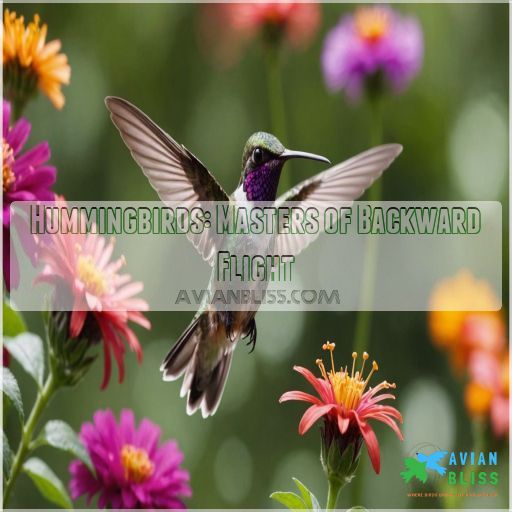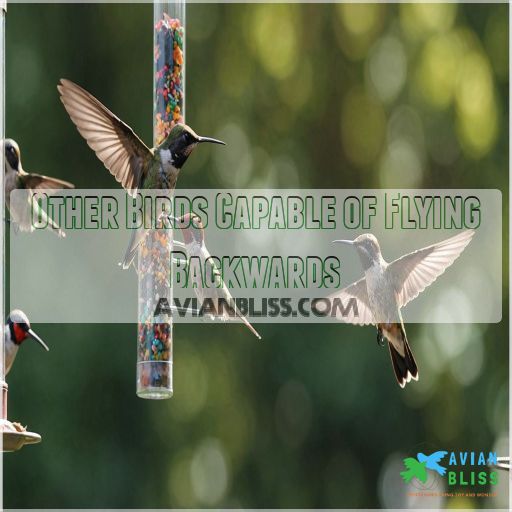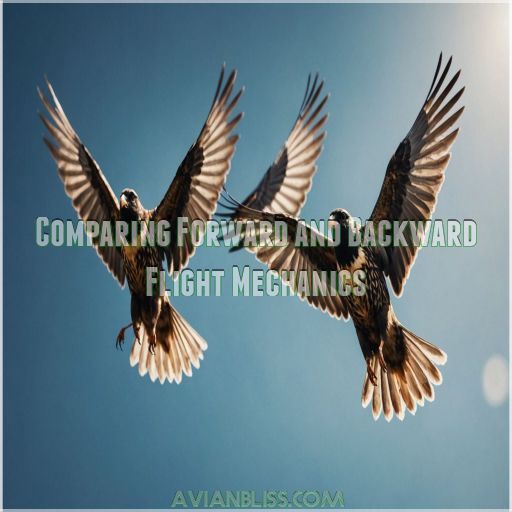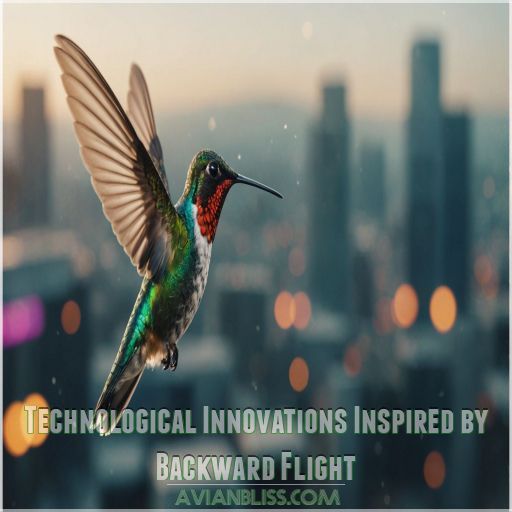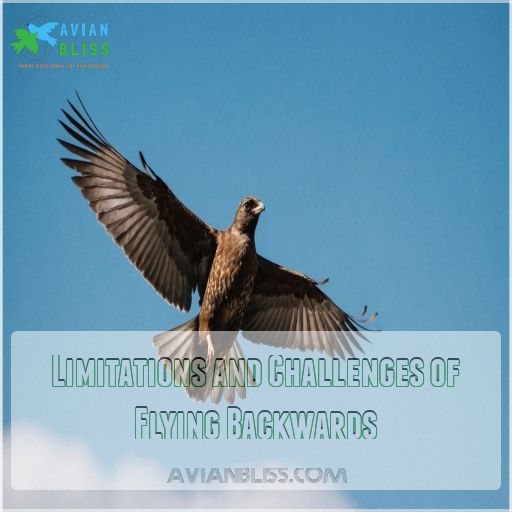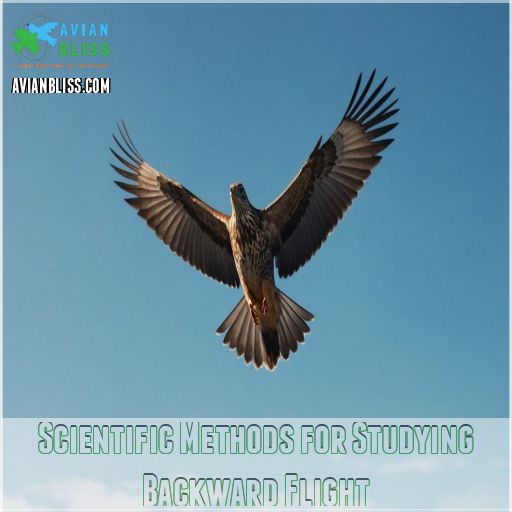This site is supported by our readers. We may earn a commission, at no cost to you, if you purchase through links.
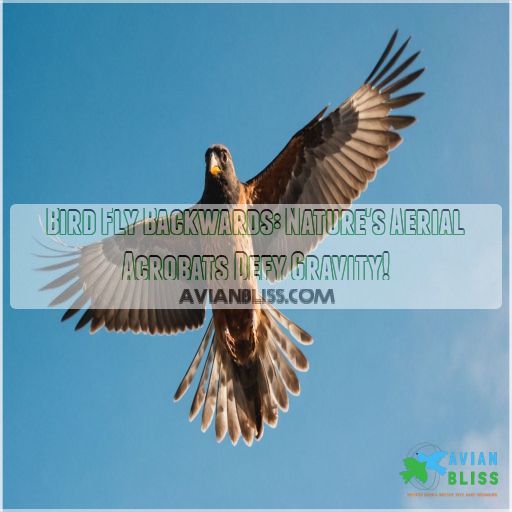
Their unique wing structure allows them to hover, dart backwards, and even fly upside down. Talk about nature’s aerial acrobats!
This backward flight isn’t just for show – it helps hummingbirds extract nectar from flowers without crushing delicate petals. It’s like they’ve found nature’s reverse gear.
Other birds, like European starlings and pied-billed grebes, can pull off short backward stunts too. But there’s more to this avian magic trick than meets the eye…
Table Of Contents
- Key Takeaways
- The Mechanics of Backward Flight in Birds
- Hummingbirds: Masters of Backward Flight
- Other Birds Capable of Flying Backwards
- Evolutionary Advantages of Backward Flight
- Comparing Forward and Backward Flight Mechanics
- Insects That Fly Backwards: a Comparative Analysis
- Technological Innovations Inspired by Backward Flight
- Limitations and Challenges of Flying Backwards
- Backward Flight in Myths and Folklore
- Scientific Methods for Studying Backward Flight
- Frequently Asked Questions (FAQs)
- Can a bird fly backwards?
- Which avian species can fly backwards?
- Can flies fly backwards?
- Which bird flutters backwards?
- What is the mythical bird that flies backwards?
- Can a pigeon fly backwards?
- Why do birds fly in a reverse V?
- Can owls fly backwards?
- Can birds fly upside down?
- How do hummingbirds store energy for migration?
- What should I do if a hummingbird is trapped indoors?
- Are there dangers in using red dye in hummingbird feeders?
- How can window collisions be prevented for hummingbirds?
- Conclusion
Key Takeaways
- You won’t believe it, but hummingbirds are like nature’s little helicopters. They’re the only birds that can fly backward, forward, and even upside down. Their unique wing structure lets them pull off these gravity-defying stunts, making them the ultimate aerial acrobats.
- Who knew that flying backward could be so efficient? Hummingbirds actually use about 20% less energy flying backward than when hovering. It’s as if they’ve found nature’s reverse gear while sipping nectar from flowers without squishing the petals.
- While most birds aren’t built for backward flight, a few can manage short bursts. European starlings and grebes can do brief backward maneuvers, showing off their agility when they need to dodge a predator or make a quick getaway.
- Turns out, backward flight isn’t just for show; it’s a lifesaver in the bird world. Hummingbirds use it to dodge predators, defend their territory, and impress potential mates with their cool, reverse-circling stunts. Talk about multitasking!
The Mechanics of Backward Flight in Birds
You might think birds can only fly forward, but some feathered acrobats can actually zip backward through the air.
Let’s explore the fascinating mechanics that allow certain birds to defy gravity and fly in reverse.
From their unique wing structures to the aerodynamic wizardry that makes this seemingly impossible feat a reality.
Wing Structure and Musculature
Imagine this: you’re a bird, ready to defy gravity and fly backwards. Your wing structure and musculature are the secret weapons.
Let’s explore what makes this aerial acrobatics possible:
- Lightweight, hollow bones for agility, similar to how some birds utilize vertical takeoff mechanisms to achieve lift during takeoff.
- Powerful breast muscles attached to an enlarged sternum, which also enable birds to generate the rapid wing beats required for vertical flight.
- Flexible wing joints allowing unique rotations
- Specialized muscle fibers for rapid contractions.
These adaptations give birds the strength and flexibility to pull off their backwards flying stunts. It’s like having a built-in jetpack, but way cooler!
Aerodynamic Principles of Reverse Motion
When you think about birds flying backwards, it’s like watching a magic trick unfold in the sky.
The aerodynamic wizardry behind this feat is nothing short of amazing. Birds that can pull off this aerial moonwalk, like hummingbirds, have to completely flip the script on normal flight mechanics.
They create wing-tip vortices and reverse airflow patterns, all while preventing stalls and reducing drag.
It’s nature’s way of defying gravity with style!
Energy Requirements for Backward Flight
You’d think flying backwards would be a real energy-guzzler, right? Well, hold onto your feathers!
For hummingbirds, it’s surprisingly efficient. They actually use about 20% less energy flying backwards than when hovering .
It’s like they’ve found nature’s reverse gear! Their unique metabolism burns through glucose and fructose faster than you can say " sugar rush" , powering those lightning-quick wing beats without breaking a sweat.
Control and Stability During Backward Movement
Controlling backward flight is like riding a bike with your eyes closed – tricky but not impossible! Birds must master a delicate dance of:
- Tail feather adjustments for steering
- Body orientation shifts to maintain balance
- Wing angle tweaks to manage air resistance
- Visual cue processing for navigation
While hummingbirds are the undisputed champs of reverse flying, other birds can pull off brief backward maneuvers when the situation calls for it . It’s nature’s way of keeping predators on their toes!
Hummingbirds: Masters of Backward Flight
You’ve probably seen hummingbirds zipping around flowers.
Their unique wing muscles and figure-eight motion allow them to hover, fly forward, and even reverse direction with ease.
Making them true masters of aerial acrobatics.
Unique Wing Adaptations in Hummingbirds
While most birds struggle with backward flight, hummingbirds have evolved unique wing adaptations that make them aerial acrobats.
You’ll be amazed by their specialized features:
| Adaptation | Benefit |
|---|---|
| Flexible shoulder joints | 180° wing rotation |
| Short, thick humerus | Quick wing movement |
| Powerful flight muscles | Sustained hovering |
| Thin, strong flight feathers | Efficient flapping |
| Fused bones | Lightweight frame |
These adaptations allow hummingbirds to hover, fly sideways, and even backwards with astonishing energy efficiency. Talk about nature’s little showoffs!
Figure-Eight Wing Motion Technique
The figure-eight wing motion is the secret behind a hummingbird’s aerial wizardry. You’ll be amazed at how these tiny acrobats pull off their backwards flight, which also enables them to defy strong headwinds with their impressive wing morphing techniques. This remarkable ability to adapt to wind currents is a clear indication of their remarkable flying skills.
- Wings beat up to 5400 times per minute
- Rotator cuff allows for 360-degree movement
- Figure-eight pattern creates constant lift
This incredibly efficient technique lets hummingbirds zip from flower to flower like nature’s tiny helicopters, sipping nectar with pinpoint precision(Check out hummingbird anatomy)
. It’s as if they’ve mastered the art of flying in reverse!
Hovering and Backward Flight Relationship
You’ve seen hummingbirds hover like tiny helicopters, but did you know they’re aerial masters of reverse too?
Their unique flight muscles pull wings in three directions: up-down, back-forth, and twisting .
This multi-directional control isn’t just for show – it’s their secret weapon for efficient hovering and seamless backward flight.
By tightening their shoulder joints, these feathered acrobats achieve incredible agility, making the shift from hovering to reverse as silk.
Nectar Feeding and Backward Flight Necessity
Imagine a tiny acrobat sipping from nature’s sweetest buffet. That’s your hummingbird, folks! These aerial masters need backward flight to efficiently feed on nectar (Source).
Their specialized tongues dart in and out up to 13 times per second, while their wings perform a dazzling figure-eight dance.
It’s not just about the sweet stuff, though – this unique ability helps them defend their floral territories too, highlighting their skill in backward flight.
Other Birds Capable of Flying Backwards
You might be surprised to learn that hummingbirds aren’t the only aerial acrobats capable of flying backwards.
While not as adept as their tiny counterparts, several other bird species can pull off brief backward maneuvers.
This group includes European starlings, pied-billed grebes, flycatchers, egrets, and herons.
European Starlings’ Brief Backward Maneuvers
Unlike the graceful hummingbird, European Starlings can execute brief backward maneuvers, surprising observers with their aerial agility.
These glossy black birds, known for their speckled winter plumage , demonstrate remarkable flight skills:
- Sudden turns and fleeing from predators
- Smooth evasive actions during territorial disputes
- Impressive pre-roosting displays in large flocks
While not as adept as hummingbirds, starlings’ ability to fly backwards briefly showcases their adaptability in the air, adding another layer to their already fascinating social behavior.
Pied-billed Grebes’ Reverse Water Takeoffs
Among the avian world’s aquatic acrobats, pied-billed grebes showcase a unique takeoff technique that’ll leave you awestruck.
These water-propelled wonders use their powerful legs and buoyancy control to initiate a backward liftoff from the water’s surface.
By tilting their heads back at an extreme angle and bringing their wings forward, grebes create an optical illusion that’ll make you do a double-take.
It’s nature’s way of adding a splash of humor to flight!
[BOLD: aquatic acrobats, backward liftoff, splash of humor]
Flycatchers’ Short Backward Bursts
How do flycatchers manage those impressive short backward bursts?
While they can’t sustain backward flight like hummingbirds, these agile birds have a trick up their wings.
When defending their territory or evading predators, flycatchers can briefly flutter backwards (Source). It’s like nature’s version of moonwalking!
Their unique wing structure allows for this quick reverse maneuver, giving them an edge in the avian world , and making them capable of briefly flutter backwards.
Egrets and Herons’ Limited Backward Flight
You’ve seen flycatchers dart backwards, but what about those elegant egrets and herons? These long-legged waders aren’t just pretty faces in the marsh.
They can pull off some nifty aerial tricks too! While they can’t sustain backward flight like hummingbirds, egrets and herons can briefly hover backwards when they need to protect themselves.
It’s like watching a feathered moonwalk – short, sweet, and surprisingly graceful!
Evolutionary Advantages of Backward Flight
You might think flying backward is just a party trick, but for some birds, it’s a game-changer in the evolutionary arena.
From snagging nectar to dodging predators, this unique ability has given certain species a serious edge in survival and reproduction.
Efficient Nectar Extraction From Flowers
Three key adaptations make hummingbirds nature’s nectar-extracting ninjas. Their long, specialized beaks allow them to reach deep into flowers, while their ability to hover lets them access hard-to-reach blooms.
But it’s their backward flight that’s the real game-changer.
By zipping in reverse, these tiny acrobats can efficiently sip nectar without crushing delicate petals, ensuring a steady supply of that sweet, energy-rich bribe flowers offer for pollination services.
Predator Evasion Tactics
You might think backward flight is just for sipping nectar, but it’s a lifesaver when predators come calling!
Birds have evolved some clever tricks to dodge danger:
- Quick backward darts to avoid approaching threats
- Freezing in place to become "invisible"
- Retreating to nest holes for safety
- Outmaneuvering hawks with agile flight
Talk about giving predators the slip! These feathered acrobats prove that sometimes the best way forward is backward.
Territorial Defense Strategies
Ever wondered how birds defend their turf without retreating?
Backward flight is their secret weapon! Hummingbirds, those feisty aerial acrobats, use this unique ability to protect their precious nectar sources.
They’ll zoom backwards, chattering and flaring their neck feathers, to confront intruders head-on. This aggressive tactic allows them to maintain control over their feeding grounds.
Ensuring a steady supply of energy for their high-speed lifestyles is crucial to their survival, and protect their turf in this manner is essential to achieving that goal.
Courtship Display Enhancement
While defending territory is impressive, backward flight truly shines in courtship displays.
You’ll be amazed by the aerial acrobatics birds perform to woo their mates:
- Red-tailed tropicbirds fly backwards in circles, waving their tails
- Laysan albatrosses combine moves like the "sky snap" and "bob strut"
- Red-capped manakins moonwalk along branches
- Costa’s hummingbirds twist acrobatically mid-air
These reverse flight courtship rituals are nature’s way of saying, "Hey good-looking, check out my wing patterns!
Comparing Forward and Backward Flight Mechanics
You might think birds only fly forward, but some can pull off the ultimate aerial trick: flying backward.
Let’s compare how birds manage their forward and backward flight, looking at differences in wing beats, maneuverability, and the air flow around their wings.
Wing Beat Frequency Differences
Regarding flying backwards, birds don’t just flip a switch – they rev up their wing engines!
Hummingbirds, nature’s tiny helicopters, crank up their wing beat frequency from 39.7 Hz in forward flight to a buzzing 43.8 Hz when reversing.
It’s like they’re shifting gears to tackle the aerial u-turn. This faster flapping helps these feathered acrobats maintain stability and control while defying gravity in reverse.
Maneuverability and Agility Comparisons
Birds perform aerial stunts that would make a fighter pilot jealous. In forward flight, they are speed demons. However, the real magic happens in backward flight.
Hummingbirds, nature’s little acrobats, excel at this. They can change direction faster than you can blink . Their ability makes them seem like tiny helicopters, zipping backward with ease.
Other birds, like starlings, can manage brief backward bursts. Yet, this is not their forte.
Air Flow Patterns Around Wings
Air flow patterns around wings are like invisible rivers, shaping a bird’s aerial dance.
In forward flight, air glides smoothly over the wing’s curved upper surface, creating lift .
But when flying backwards, it’s a whole new ballgame! The wing’s angle changes dramatically, causing air to swirl and eddy in unexpected ways. This turbulent tango requires birds to be master acrobats, constantly adjusting their wing shape to stay aloft.
Insects That Fly Backwards: a Comparative Analysis
You might think birds are the only creatures that can fly backward, but insects have some impressive aerial tricks up their sleeves too.
Let’s explore how dragonflies, bees, butterflies, and hoverflies use their unique adaptations to pull off some gravity-defying backward maneuvers that’ll make your head spin, showcasing their aerial tricks.
Dragonflies’ Acrobatic Backward Flight
Dragonflies pull off aerial stunts that’ll make your head spin! These winged wonders can zip backward with ease, thanks to their incredible wing mechanics.
Let’s take a closer look at their acrobatic abilities:
- Independent wing control
- Strong, flexible wings
- Adjustable wing shape and angle
- Unique muscle attachments
Their backward flight isn’t just for show – it’s a key tool for hunting and evading predators. With flight speeds up to 34 mph, dragonflies are true masters of the skies.
Bees’ Asynchronous Flight Muscles
Bees buzz to a different beat! Unlike dragonflies, these tiny aviators employ asynchronous flight muscles, a marvel of evolutionary engineering.
These high-frequency powerhouses don’t rely on one-to-one nerve signals . Instead, they’re like a well-oiled machine, using stretch activation to maintain rapid wing oscillations.
It’s nature’s way of saying, "Work smarter, not harder!" This clever adaptation allows bees to achieve impressive flight frequencies and efficiency.
Butterflies’ Reverse Flutter Techniques
You might be surprised to learn that butterflies, those delicate aerial dancers, can’t actually fly backwards . Unlike their agile cousins, the hawk moths, butterflies lack the wing structure for reverse flight.
When they need to change direction, they simply turn around.
This limitation doesn’t hold them back, though. Butterflies have evolved other impressive techniques for nectar extraction and predator evasion that make them nature’s beautiful acrobats.
Hoverflies’ Backward Hovering Abilities
While butterflies flutter backwards with delicate grace, hoverflies take aerial acrobatics to a whole new level.
These buzzing marvels can hang motionless in mid-air, then zip backwards faster than you can blink . It’s like they’ve got tiny jet packs!
Their secret? Incredibly agile wings that beat up to 40 km/h in any direction. Talk about freedom in flight – these little guys are nature’s escape artists!
Their speed and agility are a remarkable sight to behold, with wings that can beat at speeds of up to 40 km/h, allowing them to make sharp turns and quick changes in direction, giving them tiny jet packs.
Technological Innovations Inspired by Backward Flight
You’ll be amazed at how nature’s backward flyers are inspiring cutting-edge technology.
From tiny drones that mimic hummingbirds to revolutionary aircraft designs, engineers are taking cues from these avian acrobats to create machines that push the boundaries of flight.
The Nano Hummingbird Drone
Insects aren’t the only ones pulling off backward aerial feats.
Enter the Nano Hummingbird: a tiny drone that’s giving new meaning to "bird watching" .
This pint-sized spy in the sky can hover, climb, and even fly backwards, just like its feathered inspiration.
With a camera tucked inside its 6.5-inch frame, it’s a high-tech hummingbird that’s got both whimsy and espionage potential.
Talk about nature-inspired gadgetry!
Biomimetic Aircraft Designs
Hummingbirds’ unique flying abilities have sparked a revolution in aircraft design.
Engineers are now crafting planes that mimic these aerial acrobats, drawing inspiration from their flexible wing movements and figure-eight wing beats .
You’ll find these nature-inspired marvels pushing the boundaries of what’s possible in the air.
From gliders with albatross-like wings to agile jets channeling falcon aerodynamics, biomimetic designs are taking flight in ways that’ll make your head spin faster than a hummingbird’s wings!
Advanced Flight Control Systems
The marvels of nature inspire cutting-edge flight control systems. You’ll be amazed at how engineers are mimicking hummingbirds’ incredible backward flight abilities.
By studying their rapid wing movements and directional sensitivity, researchers are developing advanced drone technologies with unparalleled maneuverability.
These biomimetic drones use artificial muscles and sophisticated artificial muscles to achieve stable, autonomous autonomous flight in any direction.
Imagine a world where drones effortlessly zip backwards, like their feathered counterparts!
Search and Rescue Applications
Imagine a world where drones zip through disaster zones like hummingbirds, darting backwards to avoid obstacles.
You’re witnessing the future of search and rescue tech! These nimble flyers, inspired by nature’s aerial acrobats, are revolutionizing how we find and help people in need.
With advanced obstacle avoidance and the ability to brake mid-air, these drones can navigate tricky terrain and even fly backwards like dragonflies , making them invaluable in emergencies, thanks to their ability to fly with tricky terrain.
Limitations and Challenges of Flying Backwards
You might think flying backward is a cool trick, but it’s not all fun and games for our feathered friends.
While some birds can pull off this impressive feat, it comes with a hefty price in terms of energy costs and safety risks.
Increased Energy Expenditure
Three key factors contribute to the increased energy expenditure of backward flight. Flying in reverse demands more from a bird’s muscles and metabolism.
Hummingbirds, the masters of this aerial feat, burn through energy at an astonishing rate – their metabolism is about 100 times faster than an elephant’s!
- Your heart racing like a hummingbird’s wings
- Feeling the burn of every calorie as you defy gravity
- Pushing your limits to achieve the impossible
- Marveling at a unique challenge
Reduced Visual Field and Orientation
As you watch a hummingbird zip backwards from a feeder, you might wonder how it manages without eyes in the back of its head!
This aerial acrobat faces quite a challenge when flying in reverse.
Its visual field narrows, making it harder to spot potential threats or obstacles.
It’s like trying to parallel park while looking through a straw – tricky, but not impossible for these nimble fliers!
Vulnerability to Wind Currents
When you’re flying backwards, wind currents become your nemesis. You’ll face a double whammy: reduced visual cues and increased vulnerability to gusts.
Wind currents can throw you off course faster than you can say "tailspin"!
Even hummingbirds, nature’s aerial acrobats, struggle to maintain stability in breezy conditions .
Crosswinds are particularly tricky, forcing birds to constantly adjust their wing angles and body positions to stay on track.
Impact on Overall Flight Range
While backward flight helps birds dodge pesky wind currents, it’s not all smooth sailing.
You’ll find that flying in reverse puts a real damper on a bird’s travel plans. It’s like trying to run a marathon backwards – you’re not going to set any distance records.
The extra energy needed for this aerial moonwalk means birds can’t cover as much ground as they’d flying forward, which really puts a damper on their travel plans and affects their overall flying distance records.
Backward Flight in Myths and Folklore
You’ve heard of birds flying forwards, but what about backwards?
Let’s explore the fascinating world of mythical reverse-flyers, from the British Oozlum bird to North America’s Goofus bird.
These legendary creatures have captured our imagination for generations.
The Oozlum Bird of British Folklore
You’ve heard of birds flying backwards, but have you met the Oozlum bird? This comical creature from British folklore takes backward flight to a whole new level.
Legend has it, the Oozlum bird flies ever-decreasing circles until it vanishes up its own rear end! It’s said to have enormous, lidless eyes that can rotate 180 degrees, even inward for some self-reflection.
Talk about a bird’s eye view!
North America’s Legendary Goofus Bird
The Goofus bird, North America’s answer to the Oozlum, is a legendary creature that’s captured imaginations for generations.
This mythical bird supposedly flies backward, keeping its eyes on where it’s been rather than where it’s going.
Like the hummingbird’s real-life backward flight , the Goofus bird’s alleged aerial antics have sparked curiosity and wonder.
Its origins are as elusive as its flight pattern, leaving ornithologists and folklorists scratching their heads.
Cultural Significance of Reverse-Flying Birds
Reverse-flying birds have long captured our imagination, soaring through the world of mythology and folklore.
These peculiar creatures often symbolize:
- Unconventional wisdom
- Introspection and self-reflection
- The ability to see beyond the obvious
You’ll find tales of the Oozlum Bird, known for its backwards flight to admire its own tail or keep dust out of its eyes. Similarly, the Goofus bird flies upside down and backwards, supposedly to stay warm.
Modern Interpretations in Literature and Media
In the wake of mythical tales, you’ll find backward-flying birds soaring through modern literature and media. They’ve become symbols of defiance, humor, and the unexpected.
| Medium | Example | Symbolism |
|---|---|---|
| Animated Films | "Up, Up, and Backwards!" | Overcoming odds |
| Sci-Fi Series | "The Goofus Effect" | Time manipulation |
| Tech Branding | "Retroflyte Innovations" | Unconventional thinking |
| Video Games | "Hummingbird Hero" | Agility, precision |
| Fantasy Books | "The Reverse Raven" | Wisdom, rebellion |
These interpretations often inspire technological innovations, blending fantasy with real-world applications.
Scientific Methods for Studying Backward Flight
You might wonder how scientists unravel the mysteries of backward flight in birds.
From high-speed cameras capturing every wing beat to wind tunnels simulating aerial acrobatics, researchers employ cutting-edge tech to decode nature’s aerial marvels.
High-Speed Photography and Videography Techniques
Capturing birds in backward flight is like trying to snap a photo of a ninja mid-backflip – tricky, but not impossible. You’ll need some serious camera gear and lightning-fast reflexes.
- Crank up your shutter speed to at least 1/1000-1/3200 of a second
- Use continuous autofocus (AF-C or AI Servo) to track your feathered acrobat
- Set your camera to its highest frame rate for a rapid-fire burst of images
With these tips, you’ll be freezing time and capturing avian aerobatics in no time!
Wind Tunnel Experiments and Simulations
You’ve seen high-speed cameras capture bird flight, but wind tunnels take it to a whole new level.
Scientists use these controlled environments to study how birds fly backwards. By adjusting airflow speeds and angles, researchers can simulate various flight conditions.
They measure wingspan, wing area, and body posture to understand how birds adapt to different speeds. It’s like putting a bird through an aerial obstacle course – for science!
Tracking Devices for Wild Bird Flight Patterns
Tracking wild birds’ flight patterns has come a long way since the 1960s’ woodchuck experiments, with scientists now understanding the aerodynamic benefits of V formation flying
. Today, you’ve got a bird’s-eye view of migration thanks to high-tech gadgets.
Let’s flutter through the top three tracking marvels:
- GPS transmitters
- Solar geolocators
- Cellular network tags
These nifty devices are helping scientists unravel the mysteries of bird migration, from timing to routes . Just imagine following a thrush for 400 miles by plane – talk about winging it!
Computer Modeling of Reverse Flight Mechanics
Computer modeling has taken flight in avian research. Thanks to AI-powered simulations, scientists can now study backward flight mechanics without ruffling any feathers.
These virtual birds don’t just wing it – they’re programmed with intricate details of wing morphing and fluid dynamics .
By tweaking variables like air currents and muscle tension, researchers are optimizing their understanding of how birds pull off these gravity-defying stunts. It’s like having a bird’s-eye view of nature’s most impressive aerial acrobats!
Frequently Asked Questions (FAQs)
Can a bird fly backwards?
In a world where pigs might fly, most birds can’t fly backwards.
Only hummingbirds have mastered this aerial moonwalk. Their unique wing structure allows them to hover, zip backwards, and even fly upside down like tiny, feathered helicopters.
Which avian species can fly backwards?
You’ll be amazed to learn that hummingbirds are the only birds capable of true backward flight.
These tiny acrobats can zip backwards, forwards, and even upside down, thanks to their unique wing structure and rotator cuff joint.
Can flies fly backwards?
Flies can’t fly backwards like dragonflies can.
They typically leap forward but can jump backwards when threatened.
So, while they perform aerial acrobatics, flying in reverse isn’t an option.
Which bird flutters backwards?
Hummingbirds, fascinating feathered flyers, famously flutter backwards.
Their wings work wonders, allowing them to hover and dodge with delightful dexterity.
With a unique ball-and-socket wing joint, they dart like dancers through the sky, charming spectators and flower alike.
What is the mythical bird that flies backwards?
The mythical Oozlum Bird from Australian and British folklore is known for its quirky habit of flying backwards.
Often to admire its tail or see where it’s been, this curious behavior makes it quite the comedic legend.
Can a pigeon fly backwards?
Pigeons can’t really fly backwards like the acrobatic hummingbird.
While some birds might flutter slightly in reverse when wind gusts push them, pigeons are more about straightforward flights and cooing, not crazy backward maneuvers .
Why do birds fly in a reverse V?
Imagine this: a reverse V formation seems like a bird’s way of defying gravity, but it actually doesn’t exist in nature.
Birds stick to the classic V to maximize energy efficiency and visual assurance during flight.
Can owls fly backwards?
Owls, graceful as they are, can’t pull off flying backwards.
Their flight is more about silent stealth and precision rather than fancy maneuvers.
For a backward flight, you’d need to look at hummingbirds instead.
Can birds fly upside down?
Ah, the age-old question – can birds really fly upside down?
Surprisingly, most can’t, as their feathers are designed to only lock together properly when facing the wind from below.
But hummingbirds? They break the mold, effortlessly zipping backwards and inverted (Source).
How do hummingbirds store energy for migration?
Hummingbirds store energy by doubling their body weight in fat before migration, thanks to a feeding frenzy called hyperphagia.
This fat fuel, tucked in pockets like a "dowager’s hump," powers their epic journeys.
What should I do if a hummingbird is trapped indoors?
If a hummingbird’s trapped indoors, open windows and doors for an escape route.
Remove red items to prevent confusion.
Lure it out with a sugar-water feeder near the exit, then give it space to leave.
Are there dangers in using red dye in hummingbird feeders?
Consuming red dye in hummingbird feeders exposes these tiny creatures to dye concentrations 17 times higher than recommended for humans.
Potentially causing health issues like tumors or liver damage.
Skip the dye; they’ll still flock to red feeder parts .
How can window collisions be prevented for hummingbirds?
To prevent hummingbirds from crashing into windows, add patterns or decals to glass surfaces, close curtains, or install external screens.
Keeping interior plants away from windows can also help reduce these disorienting reflections.
This method is supported by reference.
Conclusion
Imagine zipping through the sky, defying gravity with backward flight just like birds—it’s a feat that seems straight out of a nature documentary.
Hummingbirds top the list, showcasing how a bird can fly backwards with precise precision. These aerial acrobats have mastered maneuvers for feeding, avoiding predators, and impressing mates.
While not all birds can reverse like a hummingbird, studying their flight continues to inspire innovations, proving nature often leads the way in technology and mystery.


